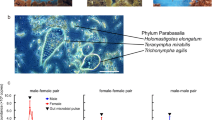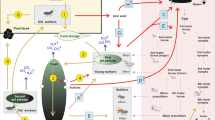Abstract
The symbiosis between lower termites and their intestinal microorganisms, essential for wood digestion, is well characterized. Termites exhibit a reproductive division of labor—kings and queens specialize in reproduction, and workers are responsible for foraging and feeding the colony members. Therefore, the gut microbial community in royals is expected to be down-regulated because it is less important than that in workers. Indeed, we recently reported that, in the termite species Reticulitermes speratus, workers have symbiotic protists; kings, and neotenic queens in mature field colonies completely lose protists in their guts. However, the dynamics of the protist community during caste differentiation remain unclear. In this study, we investigated the relationship between the abundance of intestinal protists and the neotenic differentiation of R. speratus. First, we confirmed that both sexes of late instar nymphs possessed intestinal protist communities like those of workers. Nevertheless, after molting for neotenic differentiation, they lost most of their intestinal protists and did not regain them. Based on our behavioral observation, workers, nymphs, and neotenics received proctodeal food from surrounding workers. This suggests protists can enter neotenics’ guts, while they cannot establish after the neotenic differentiation. Our study highlights that the interaction between termites and gut microbes changes dynamically during caste differentiation.




Similar content being viewed by others
Data availability
The dataset is available in Supplementary Information (Table S1, S2, S3 and S4).
Code availability
Not applicable.
References
Anderson MJ (2001) A new method for non-parametric multivariate analysis of variance. Austral Ecol 26:32–46
Anderson MJ (2006) Distance-based tests for homogeneity of multivariate dispersions. Biometrics 62:245–253
Andrew BJ (1930) Method and rate of protozoan refaunation in the termite Termopsis angusticollis Hagen. Univ California Publ Zool 33:449–470
Brent CS, Traniello JFA (2001) Social regulation of testicular development in primary and secondary males of the dampwood termite Zootermopsis angusticollis Hagen. Insectes Soc 48:384–391
Brune A (2014) Symbiotic digestion of lignocellulose in termite guts. Nat Rev Microbiol 12:168–180
Brune A, Dietrich C (2015) The gut microbiota of termites: digesting the diversity in the light of ecology and evolution. Annu Rev Microbiol 5:607–607
Brune A, Ohkuma M (2011) Role of the termite gut microbiota in symbiotic digestion. In: Roisin Y, Lo N (eds) Bignell DE. Springer, Heidelberg, pp 439–475
Carpenter KJ, Weber PK, Davisson ML, Pett-Ridge J, Haverty MI, Keeling PJ (2013) Correlated SEM, FIB-SEM, TEM, and NanoSIMS imaging of microbes from the hindgut of a lower termite: methods for in situ functional and ecological studies of uncultivable microbes. Microsc Microanal 19:1490–1501
Cleveland LR (1925a) The effects of oxygenation and starvation on the symbiosis between the termite, Termopsis, and its intestinal flagellates. Biol Bull 48:309–327
Cleveland LR (1925b) The feeding habit of termite castes and its relation to their intestinal flagellates. Biol Bull 48:295–308
Gould AL, Zhang V, Lamberti L, Jones EW, Obadia B, Korasidis N, Gavryushkin A, Carlson JM, Beerenwinkel N, Ludington WB (2018) Microbiome interactions shape host fitness. Proc Natl Acad Sci 115:E11951–E11960
Hayashi Y, Miyata H, Kitade O, Lo N (2013) Neotenic reproductives influence worker caste differentiation in the termite Reticulitermes speratus (Isoptera; Rhinotermitidae). Sociobiology 60:446–452
Inagaki T, Matsuura K (2018) Extended mutualism between termites and gut microbes: nutritional symbionts contribute to nest hygiene. Sci Nat 105
Inagaki T, Matsuura K (2016) Colony-dependent sex differences in protozoan communities of the lower termite Reticulitermes speratus (Isoptera: Rhinotermitidae). Ecol Res 31:749–755
Johnson SE, Breisch NL, Momen B, Thorne BL (2011) Morphology and gonad development of normal soldiers and reproductive soldiers of the termite Zootermopsis nevadensis nevadensis (Isoptera, Archotermopsidae). ZooKeys 148:15–30
Kitade O (2007) Characteristics and host-symbiont relationships of termite gut flagellates. Jpn J Protozool 40:101–112
Koidzumi M (1921) Studies on the intestinal protozoa found in the termites of Japan. Parasitology 13:235–309
Lainé LV, Wright DJ (2003) The life cycle of Reticulitermes spp. (Isoptera: Rhinotermitidae): what do we know? Bull Entomol Res 93:267–278
Maekawa K, Mizuno S, Koshikawa S, Miura T (2008) Compound eye development during caste differentiation in the termite Reticulitermes speratus (Isoptera: Rhinotermitidae). Zool Sci 25:699–705
Maekawa K, Ishitani K, Gotoh H, Cornette R, Miura T (2010) Juvenile Hormone titre and vitellogenin gene expression related to ovarian development in primary reproductives compared with nymphs and nymphoid reproductives of the termite Reticulitermes speratus. Physiol Entomol 35:52–58
Matsuura K, Mizumoto N, Kobayashi K, Nozaki T, Fujita T, Yashiro T, Fuchikawa T, Mitaka Y, Vargo EL (2018) A genomic imprinting model of termite caste determination: not genetic but epigenetic inheritance influences offspring caste fate. Am Nat 191(6):677–690
May E (1941) The behavior of the intestinal protozoa of termites at the time of the last ecdysis. Trans Am Microsc Soc 60:281–292
Miyata H, Furuichi H, Kitade O (2004) Patterns of neotenic differentiation in a subterranean termite, Reticulitermes speratus (Isoptera: Rhinotermitidae). Entomol Sci 7:309–314
Miyazaki S, Yoshimura M, Saiki R, Hayashi Y, Kitade O, Tsuji K, Maekawa K (2014) Intracolonial genetic variation affects reproductive skew and colony productivity during colony foundation in a parthenogenetic termite. BMC Evol Biol 14:1–7
Morisita M (1959) Measuring of interspecific association and similarity between communities. Mem Fac Sci Kyushu Univ Ser E 3:65–80
Nalepa CA (2017) What kills the hindgut flagellates of lower termites during the host molting cycle? Microorganisms 5:82
Ni J, Tokuda G (2013) Lignocellulose-degrading enzymes from termites and their symbiotic microbiota. Biotechnol Adv 31:838–850
Nishimura Y, Otagiri M, Yuki M, Shimizu M, Inoue JI, Moriya S, Ohkuma M (2020) Division of functional roles for termite gut protists revealed by single-cell transcriptomes. ISME J 14:2449–2460
Nozaki T, Matsuura K (2019) Evolutionary relationship of fat body endoreduplication and queen fecundity in termites. Ecol Evol 9:11684–11694
Nozaki T, Matsuura K (2021) Oocyte resorption in termite queens: seasonal dynamics and controlling factors. J Insect Physiol 131:104242–104242
Nutting WL (1969) Flight and colony foundation. In: Weesner FM (ed) Krishna K. Academic Press, New York, pp 233–282
Ohkuma M, Noda S, Hattori S, Iida T, Yuki M, Starns D, Inoue J, Darby AC, Hongoh Y (2015) Acetogenesis from H2 plus CO2 and nitrogen fixation by an endosymbiotic spirochete of a termite-gut cellulolytic protist. Proc Natl Acad Sci U S A 112:10224–10230
R Core Team (2020) R: A language and environment for statistical computing. R Foundation for Statistical Computing, Vienna, Austria.
Raina A, Park YI, Gelman D (2008) Molting in workers of the Formosan subterranean termite Coptotermes formosanus. J Insect Physiol 54:155–161
Roisin Y, Korb A (2011) Social organisation and the status of workers in termites. In: Roisin Y, Lo N (eds) Bignell DE. Springer, Dordrecht, pp 133–164
Rosengaus RB, Schultheis KF, Yalonetskaya A, Bulmer MS, DuComb WS, Benson RW, Thottam JP, Godoy-Carter V (2014) Symbiont-derived β-1,3-glucanases in a social insect: mutualism beyond nutrition. Front Microbiol 5:1–11
Saiki R, Maekawa K (2011) Imaginal organ development and vitellogenin gene expression changes during the differentiation of nymphoids of the termite Reticulitermes speratus. Sociobiology 58:499–511
Salem H, Bauer E, Strauss AS, Vogel H, Marz M, Kaltenpoth M (2014) Vitamin supplementation by gut symbionts ensures metabolic homeostasis in an insect host. Proc R Soc B 281:20141838–20141838
Scharf ME, Peterson BF (2021) A century of synergy in termite symbiosis research: linking the past with new genomic insights. Annu Rev Entomol 66:23–43
Schneider CA, Rasband WS, Eliceiri KW (2012) NIH Image to ImageJ: 25 years of image analysis. Nat Methods 9:671–675
Shimada K, Maekawa K (2010) Changes in endogenous cellulase gene expression levels and reproductive characteristics of primary and secondary reproductives with colony development of the termite Reticulitermes speratus (Isoptera: Rhinotermitidae). J Insect Physiol 56:1118–1124
Shimada K, Lo N, Kitade O, Wakui A, Maekawa K (2013) Cellulolytic protist numbers rise and fall dramatically in termite queens and kings during colony foundation. Eukaryot Cell 12:545–550
Sun Q, Haynes KF, Hampton JD, Zhou X (2017) Sex-specific inhibition and stimulation of worker-reproductive transition in a termite. Sci Nat 104
Weesner FM (1969a) External anatomy. In: Weesner FM, Krishna K (eds). Academic Press, New York, pp 19–47
Weesner FM (1969b) The reproductive system. In: Krishna K, Weesner FM (eds). Academic Press, New York, NY, pp 125–160
Wolda H (1981) Similarity indices, sample size and diversity. Oecologia 50:296–302
Zimet M, Stuart AM (1982) Sexual dimorphism in the immature stages of the termite, Reticulitermes flavipes (Isoptera: Rhinotermitidae). Sociobiology 7:1–6
Acknowledgements
We thank the members of the Laboratory of Insect Ecology in Kyoto University for helpful discussions and Kazuki Takahashi for the valuable comments on the manuscript. We would also like to thank Editage for English language editing.
Funding
This study was supported by funding from the Japan Society for the Promotion of Science to TI (Research Fellowship for Young Scientists No. 18J13513 and No. 20J00986) and KM (Kiban Kenkyu S No. 25221206 and No. 18H05268).
Author information
Authors and Affiliations
Contributions
TI designed experiments. TI and TN performed experiments. TI, TN, and KM wrote the manuscript, and all authors are accountable for the content and approve the final version of the manuscript.
Corresponding author
Ethics declarations
Conflict of interest
The authors declare no competing interests.
Ethics approval
Not applicable.
Consent to participate
Not applicable.
Consent for publication
Not applicable.
Supplementary Information
Below is the link to the electronic supplementary material.
Supplementary file2 (MP4 9676 KB)
Supplementary file3 (MP4 6306 KB)
Rights and permissions
Springer Nature or its licensor holds exclusive rights to this article under a publishing agreement with the author(s) or other rightsholder(s); author self-archiving of the accepted manuscript version of this article is solely governed by the terms of such publishing agreement and applicable law.
About this article
Cite this article
Inagaki, T., Nozaki, T. & Matsuura, K. Rapid elimination of symbiotic intestinal protists during the neotenic differentiation in a subterranean termite, Reticulitermes speratus. Insect. Soc. 69, 335–343 (2022). https://doi.org/10.1007/s00040-022-00877-1
Received:
Revised:
Accepted:
Published:
Issue Date:
DOI: https://doi.org/10.1007/s00040-022-00877-1




